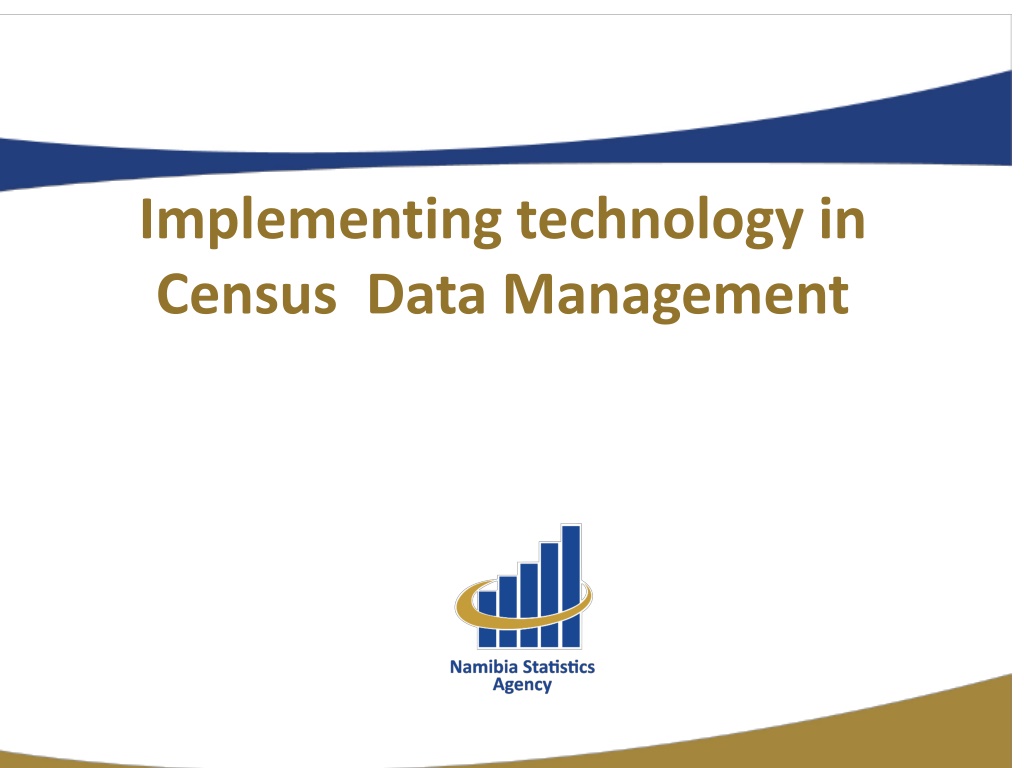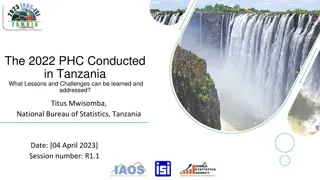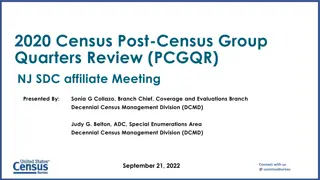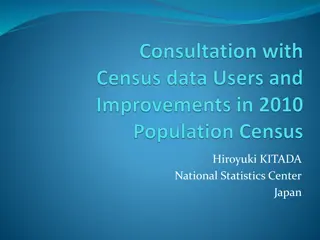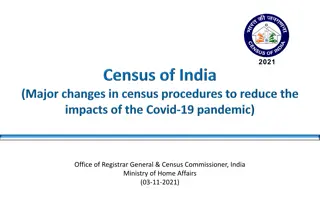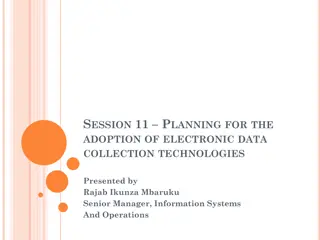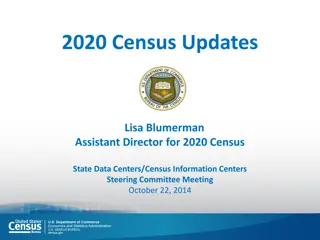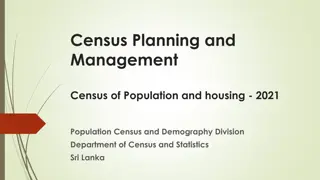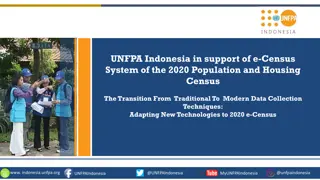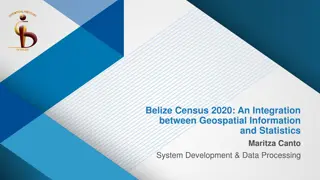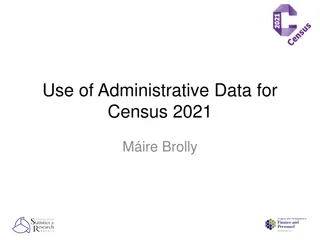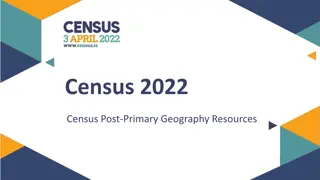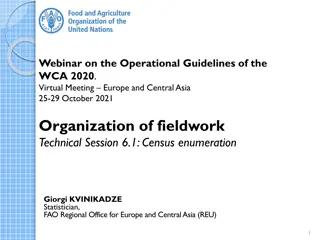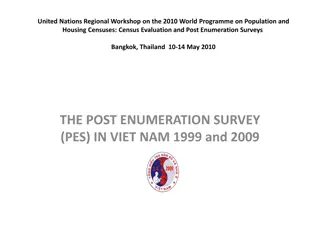Implementing Technology in Census Data Management
Utilizing technology in census data management can greatly enhance accuracy, project completion times, timeliness, and cost-effectiveness. The NSA has successfully implemented Computer-Assisted Personal Interviews (CAPI) for various surveys, leading to improved data collection efficiency. Considerations for technology implementation include software features, handheld device selection, and compatibility with tools like CSPro. The integration of CSPro by the U.S. Census Bureau has streamlined data entry, editing, and tabulation processes in surveys. Adopting CSPro software offers benefits such as case management, role segregation, and enhanced quality control in data collection and management processes.
Download Presentation

Please find below an Image/Link to download the presentation.
The content on the website is provided AS IS for your information and personal use only. It may not be sold, licensed, or shared on other websites without obtaining consent from the author.If you encounter any issues during the download, it is possible that the publisher has removed the file from their server.
You are allowed to download the files provided on this website for personal or commercial use, subject to the condition that they are used lawfully. All files are the property of their respective owners.
The content on the website is provided AS IS for your information and personal use only. It may not be sold, licensed, or shared on other websites without obtaining consent from the author.
E N D
Presentation Transcript
Implementing technology in Census Data Management
NSA goes CAPI It is better to prevent errors than to cure them later (Redman 2001)
Why NSA goes CAPI Accuracy of data collection Improved project completion time Timeliness and availability of data Flexibility of technology Cost effective ( especially for large and re- occurring surveys)
NSA and CAPI Successful stories Agriculture Census 2013/14 Used laptop Acer 15inch Namibia Household Income Expenditure Survey 2015/16 10600 HHs Namibia Inter-censual Survey 2016 - 12000HHs Labour Force Survey (NIDS) 2016 - 12000HHs NIDS and LFS 2016 took 3 months for data processing.
Census 2021 Planning Data collection tools design Considerations
Considerations of technology Software main features Case management In field automation sampling process Advanced programming languages Case tree (menu) Selection of handheld device GPS and mapping Data synchronization and backups Storage capacity Device performance in terms of processing power Compatibility with CSPro (Window & Android platform) user friendliness in terms of weight and size
NSA & Census and Survey Processing System (CSPro)
CSPro and NSA CSPro Census and Survey Processing System Developed by U.S. Census Bureau CSEntry Android application, First release in 2014 Data entry, edits and imputations and tabulation Main CSPro features Support multiple languages Sophisticated programming languages Tightly controlled path Data synchronization
Why CSPro? Case Management Segregation of roles , HH assignment, completeness and accuracy controls Interview assignments Field supervisor can assign interviews Field Supervisor overseen the completeness and quality of interviewer output Transferring data to the central server
Why CSPro? Improve data quality through.. Automated routing (skips patterns) Direct consistency checks and data validation during fieldwork Pre coded drop down menus or radio buttons More accurate measurement..e.g... GPS coordinates
Why CSPro? Data Transfer Data is transmitted via FTP including transfer protocols that encrypt and protect sensitive survey data
Why CSPro? Cont Case tree makes navigation easier Visibility of entered records on the same screen
Lessons learned from first implementation CAPI
DP- Lessons learned Planning Phase New technology without proper methodology assessment done < resources , time & costs) Advanced programming required (CSPro etc..) ,support from U.S. Census New technology for a complex survey on very tight schedule/timeline Lack of Process /Methodology change management < awareness & understanding> Design Phase Questionnaire & System specifications plan ( Business rules, edits rules, recodes, derived variables, Tabulation) needed earlier Incomplete project process data flow leads to risky continual application updates during fieldwork Not sufficient built in buffer time in the project plan Lack of project change control measures limited accountability
DP -Lessonslearned Build / Execution Android CSEntry application was being upgraded and more features added during production Insufficient testing plan and procedures < no test end-to- end > Pilot study done partially Supervisors & enumerators need basic IT skills IT risks (loss, crash, fallback) support needed
CAPI and Process Change Management ICT Infrastructures Backup and Storage of data. Need to have access to internet or USB / External drives. Data is kept on the tablets until completion of project data analysis Power Availability. Computer batteries need to be recharged . a bit difficult with remote areas with no electricity. Availability of technological support ( timely availability of IT equipments, Networking and intenet access for transfering and updating of files )
CAPI and Process Change Management Things must be done earlier than usual at least six month for a survey Tabulation plan Finalise questionnaire content Define business process flow and field structure(e.g. sampling frame) Data editing rules & specifications ( rules, upper /lower data range, derived variables and so on) Subject Matter and Data Management must co-operate more closely Invest more time on planning for all project KEY stakeholders Ensure comprehensive system testing by both stakeholders CAPI is (only) a tool - Project management & people stay essential
Implemented measures Adopted a standard data processing tool - CSPro Invested in capacity training to Key DP staff Sponsors UNFPA ,USAID, Ukaid Instructor U.S. Census Bureau 90% of the programmers are trained in Android CSPro programming Version.6.3 Improved process documentations supported by templates( specification requirements, change control, system testing procedures + sign off)
ICT implemented mitigations Secure file transmission server (sftp) Centralized encryption for data and devices and remote device management Assets inventory management Backup plans, recovery plans, redundancy and high systems availability. Internet provision for the field users, only until team supervisor level. ICT support staff during fieldwork ICT office for each region
Envisioned System Improvement Planning Start earlier with the planning and setting up project architectural for Census 2021 Questionnaire design ( indicators and edit rules) finalized earlier prior to system development atleast a year before Increase permanent data processing staff Sharing resources ( skills and devices) with other African countries Improve field quality assurance and control Develop a web-based report tool enable real time reporting at field level Monitor the enumerator progress per EA as linked to the GIS-component Timely correction and solving field problems as they occurs Management daily monitoring and progress report
